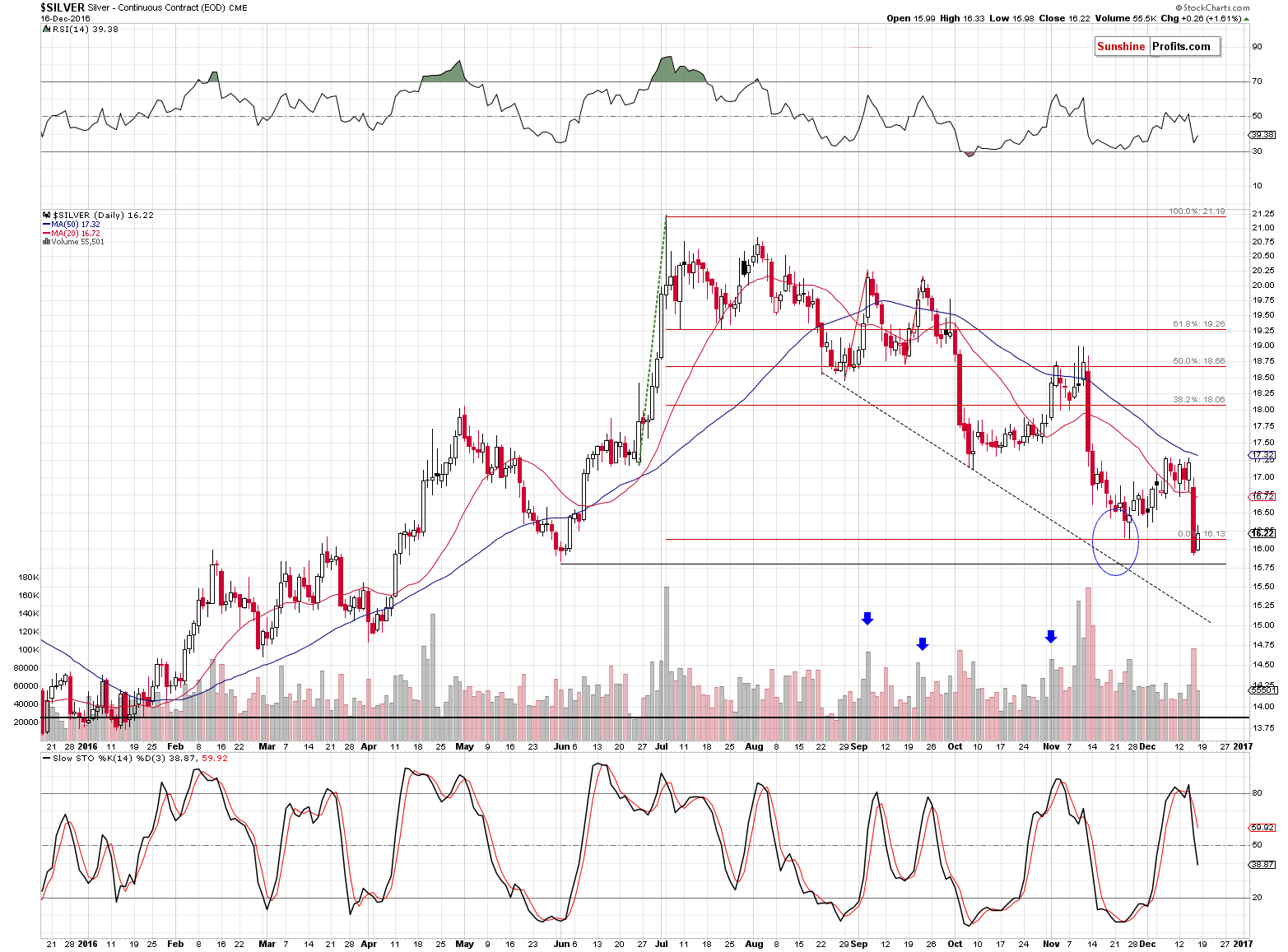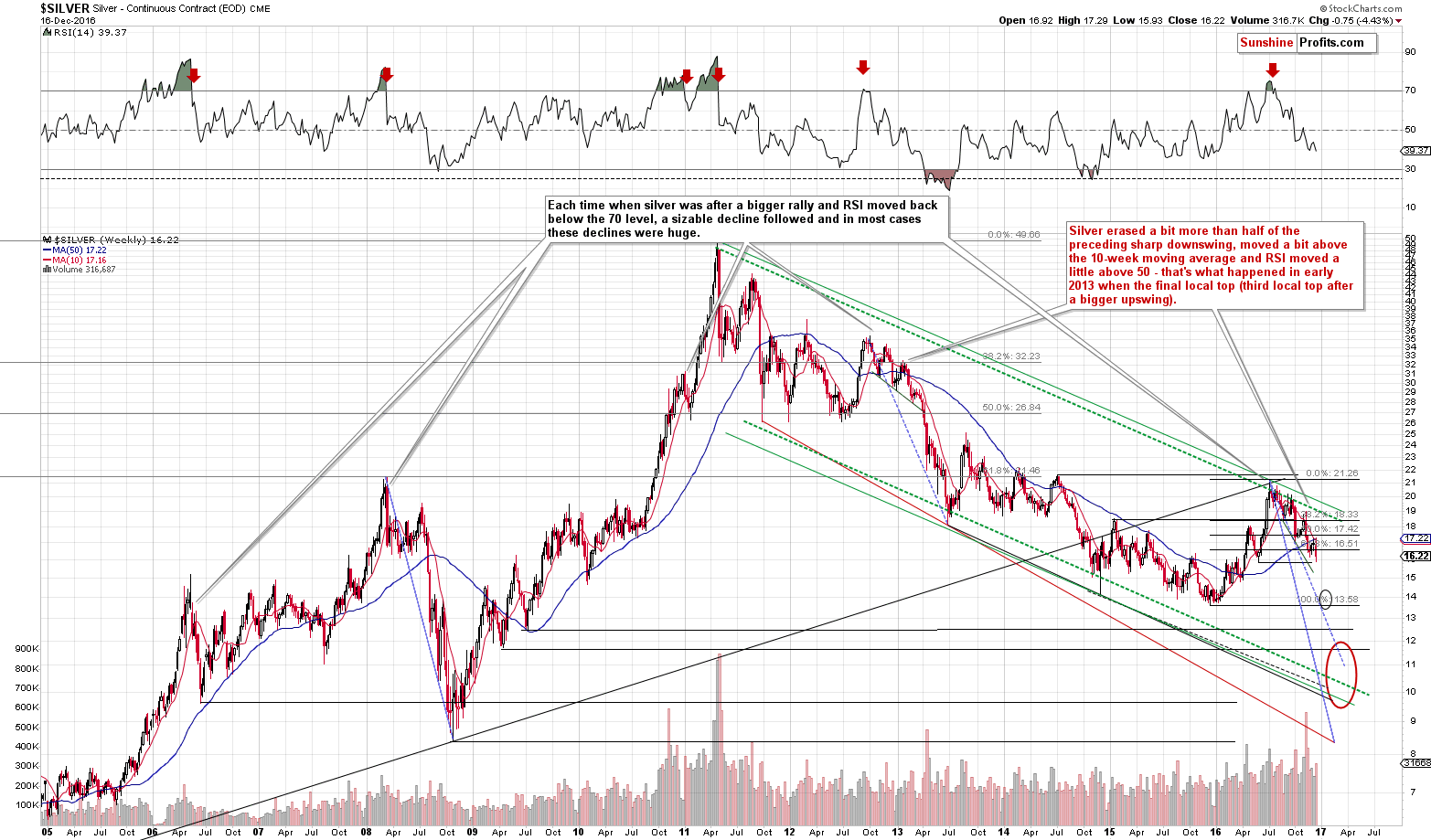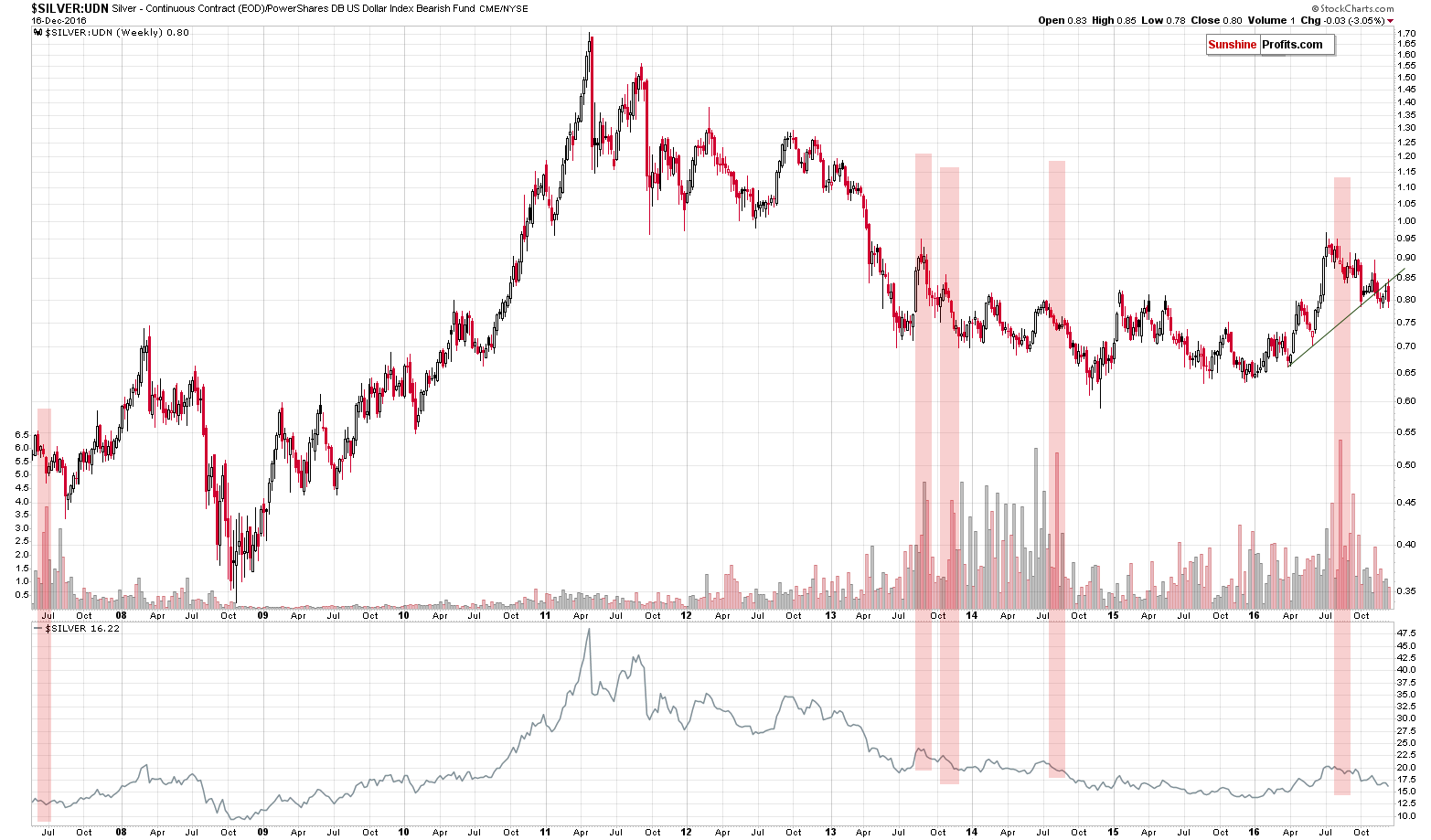Briefly: In our opinion, full (150% of the regular full position) speculative short positions in gold, silver and mining stocks are justified from the risk/reward perspective.
Last week was full of important events in gold and in the currency markets, but something very important happened also in the case of gold’s sister metal – silver. Let’s take a closer look (charts courtesy of http://stockcharts.com).

From the short-term point of view, we simply saw a small correction to the previous lows that materialized on relatively low volume. That’s a classic bearish confirmation and there’s not much more that we can say about it.

The long-term silver chart is much more interesting. The analogy to the 2013 decline remains in place and it has several interesting and important implications. Back in 2012 – 2013, there were 3 small tops and one tiny pause before the plunge really started. We are already after 3 small tops and it could be the case that the tiny pause has just begun. Could – but doesn’t have to be the case, as history rhymes instead of repeating itself to the letter. The implication here is that even if a very small corrective upswing is to be seen, it most likely isn’t worth it to close the short position – the move will probably be (if it really materializes, that is) very small, so the risk would be to be out of the market due to the chance of missing profits on the decline.
Speaking of the profits on the decline, the move is likely to be very significant in terms of both price and time. In other words, silver is likely to fall hard and to fall quick. The blue dashed line shows the path to the final bottom assuming that the current decline is just like the 2012 – 2013 one. Will it really be alike? That’s likely - since it’s been very similar so far, it’s likely that it will continue to be similar at least for some time (weeks).
The key thing that we can infer from the above chart and this analogy is where silver is likely to have its next short-term bottom. Back in 2013, silver declined until it reached the previous important support level. Back then, it was the 2008 top that served as resistance - silver bottomed a bit above it.
Once silver breaks below the May / June bottom, there is no strong support until the 2015 bottom, so that’s where we are likely to see the next short-term bottom in the case of the white metal.
The RSI indicator is at about 40 and it would need to decline below 30 to indicate a situation similarly oversold to the one that we saw in the first half of 2013. The above confirms our earlier predictions – silver is likely to decline much further before a bigger corrective upswing takes place.
What about silver seen from the non-USD perspective (the average of prices of silver in terms of currencies other than the USD)?

We saw an important breakdown, which was confirmed and verified by a move back to the previously broken support line, which now proved to be a strong resistance. The implications are bearish.
Summing up, it seems that silver will decline much further before the next important corrective upswing is seen, and the same is likely to be the case for the rest of the precious metals sector. If we see meaningful bullish signs, we may temporarily close the current speculative short positions or adjust them, but at this time, this is not the case.
Also, let’s keep in mind that the upcoming big decline in the precious metals sector is likely to create a great buying opportunity in the case of the long-term investment capital - be sure to prepare yourself for it.
As always, we will keep you – our subscribers – updated.
To summarize:
Trading capital (supplementary part of the portfolio; our opinion): Short positions (150% of the full position) in gold, silver and mining stocks are justified from the risk/reward perspective with the following stop-loss orders and initial target price levels:
- Gold: initial target price: $1,006; stop-loss: $1,183; initial target price for the DGLD ETN: $88.88; stop-loss for the DGLD ETN $58.77
- Silver: initial target price: $13.12; stop-loss: $17.53; initial target price for the DSLV ETN: $46.18; stop-loss for the DSLV ETN $24.86
- Mining stocks (price levels for the GDX ETF): initial target price: $9.34; stop-loss: $22.62; initial target price for the DUST ETF: $143.56; stop-loss for the DUST ETF $41.88
In case one wants to bet on junior mining stocks' prices (we do not suggest doing so – we think senior mining stocks are more predictable in the case of short-term trades – if one wants to do it anyway, we provide the details), here are the stop-loss details and initial target prices:
- GDXJ ETF: initial target price: $14.13; stop-loss: $38.12
- JDST ETF: initial target price: $104.26; stop-loss: $28.88
Long-term capital (core part of the portfolio; our opinion): No positions (in other words: cash)
Insurance capital (core part of the portfolio; our opinion): Full position
Plus, you might want to read why our stop-loss orders are usually relatively far from the current price.
Please note that a full position doesn’t mean using all of the capital for a given trade. You will find details on our thoughts on gold portfolio structuring in the Key Insights section on our website.
As a reminder – “initial target price” means exactly that – an “initial” one, it’s not a price level at which we suggest closing positions. If this becomes the case (like it did in the previous trade) we will refer to these levels as levels of exit orders (exactly as we’ve done previously). Stop-loss levels, however, are naturally not “initial”, but something that, in our opinion, might be entered as an order.
Since it is impossible to synchronize target prices and stop-loss levels for all the ETFs and ETNs with the main markets that we provide these levels for (gold, silver and mining stocks – the GDX ETF), the stop-loss levels and target prices for other ETNs and ETF (among other: UGLD, DGLD, USLV, DSLV, NUGT, DUST, JNUG, JDST) are provided as supplementary, and not as “final”. This means that if a stop-loss or a target level is reached for any of the “additional instruments” (DGLD for instance), but not for the “main instrument” (gold in this case), we will view positions in both gold and DGLD as still open and the stop-loss for DGLD would have to be moved lower. On the other hand, if gold moves to a stop-loss level but DGLD doesn’t, then we will view both positions (in gold and DGLD) as closed. In other words, since it’s not possible to be 100% certain that each related instrument moves to a given level when the underlying instrument does, we can’t provide levels that would be binding. The levels that we do provide are our best estimate of the levels that will correspond to the levels in the underlying assets, but it will be the underlying assets that one will need to focus on regarding the signs pointing to closing a given position or keeping it open. We might adjust the levels in the “additional instruments” without adjusting the levels in the “main instruments”, which will simply mean that we have improved our estimation of these levels, not that we changed our outlook on the markets. We are already working on a tool that would update these levels on a daily basis for the most popular ETFs, ETNs and individual mining stocks.
Our preferred ways to invest in and to trade gold along with the reasoning can be found in the how to buy gold section. Additionally, our preferred ETFs and ETNs can be found in our Gold & Silver ETF Ranking.
As always, we'll keep you - our subscribers - updated should our views on the market change. We will continue to send out Gold & Silver Trading Alerts on each trading day and we will send additional Alerts whenever appropriate.
The trading position presented above is the netted version of positions based on subjective signals (opinion) from your Editor, and the Tools and Indicators.
As a reminder, Gold & Silver Trading Alerts are posted before or on each trading day (we usually post them before the opening bell, but we don't promise doing that each day). If there's anything urgent, we will send you an additional small alert before posting the main one.
=====
Latest Free Trading Alerts:
Retail sales rose 0.1 percent, while the CPI jumped 0.2 percent in November. What does it mean for the gold market?
November Retail Sales, CPI and Gold
S&P 500 index extended its short-term consolidation on Friday. Is this a topping pattern or just flat correction before another leg up? Is holding short position still justified?
Stock Trading Alert: More Short-Term Fluctuations Along Record Highs - Which Direction Is Next?
=====
Hand-picked precious-metals-related links:
PRECIOUS-Gold up on dollar retreat, tighter U.S. policy caps gains
With Gold Prices Stuck in ‘Purgatory,’ Hedge Funds Pull Out
Gold outlook is hostage to uncertain Trump and India: Russell
Shuttered Gold Mine Shows Investors Risks of Thai Power Grab
Gold imports shrink 30.5% to USD 15.7 bn in April-November
=====
In other news:
Futures slightly higher ahead of Yellen speech
Modi’s Cash Ban May Have Been in Vain as India Outlook Dims
Scotland Threatens to Leave U.K. If Forced Out of Single Market
=====
Thank you.
Sincerely,
Przemyslaw Radomski, CFA
Founder, Editor-in-chief, Gold & Silver Fund Manager
Gold & Silver Trading Alerts
Forex Trading Alerts
Oil Investment Updates
Oil Trading Alerts



